Salvaged sounds
by D.E. Bentley –
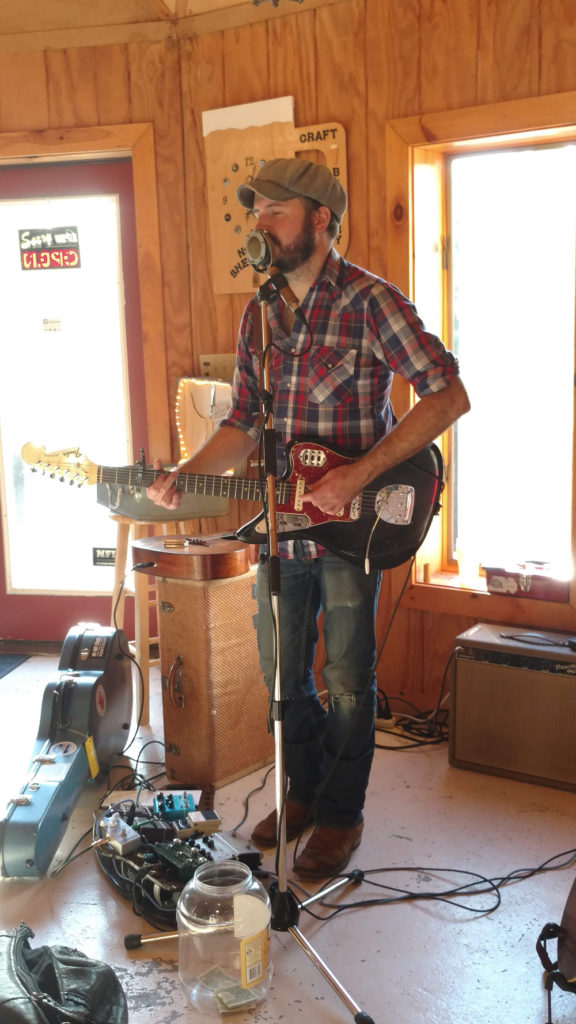
Most people have a favorite era that they like to reminisce about. For Mike Brown, owner of Temperamental Recordings in Groveland, NY, that era is the time between the World Wars, before many of the great luthiers – individuals skilled in the crafting and repair of string instruments – were called to fight. After the war, many of these talented artists were gone, and instrument quality suffered. As a music producer, songwriter, musician and picker, Brown’s interest in the early decades of the twentieth century is intricately entwined with his love of music and musical instruments, particularly string instruments.
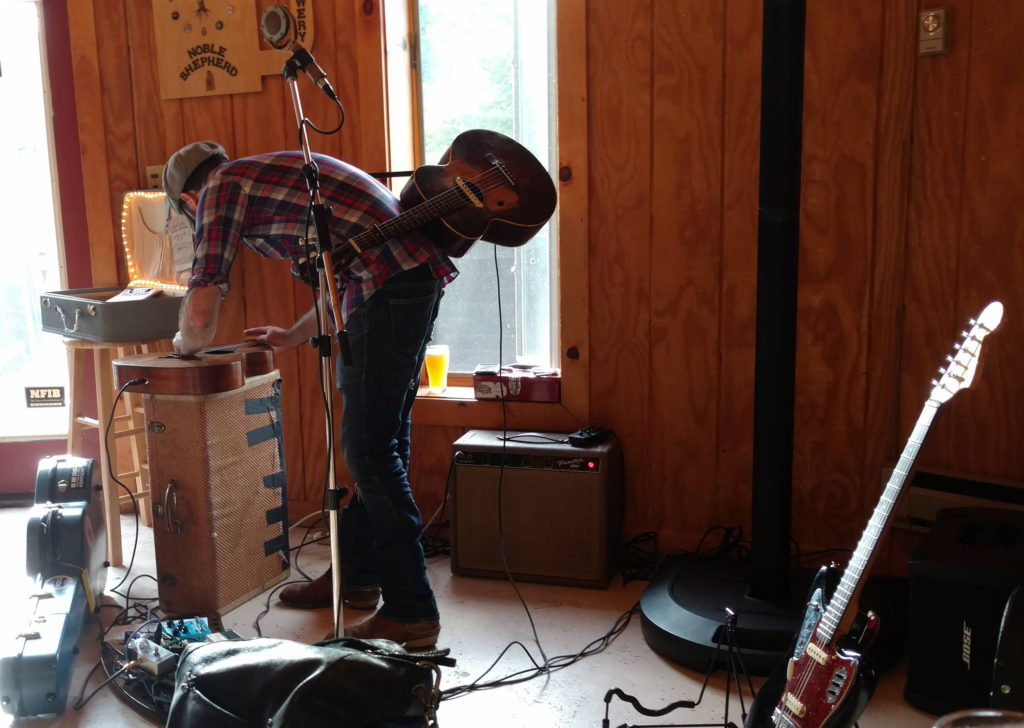 Brown’s love of older instruments is evident when you see him perform, as we did on Friday the 14th at Noble Shepherd Brewery. His Gibson travel guitar is the giveaway. The 1925 Gibson has been his touring guitar for fifteen years – and it shows. He also has a Gibson 1926 that he rarely takes on the road – touring is tough on instruments. Brown builds deep and enduring relationships with the instruments he plays, and the Gibson is the guitar he developed his signature “looping phat stuff” on. Despite years of wear and tear, and needed repair, it still sounds great.
Brown’s love of older instruments is evident when you see him perform, as we did on Friday the 14th at Noble Shepherd Brewery. His Gibson travel guitar is the giveaway. The 1925 Gibson has been his touring guitar for fifteen years – and it shows. He also has a Gibson 1926 that he rarely takes on the road – touring is tough on instruments. Brown builds deep and enduring relationships with the instruments he plays, and the Gibson is the guitar he developed his signature “looping phat stuff” on. Despite years of wear and tear, and needed repair, it still sounds great.
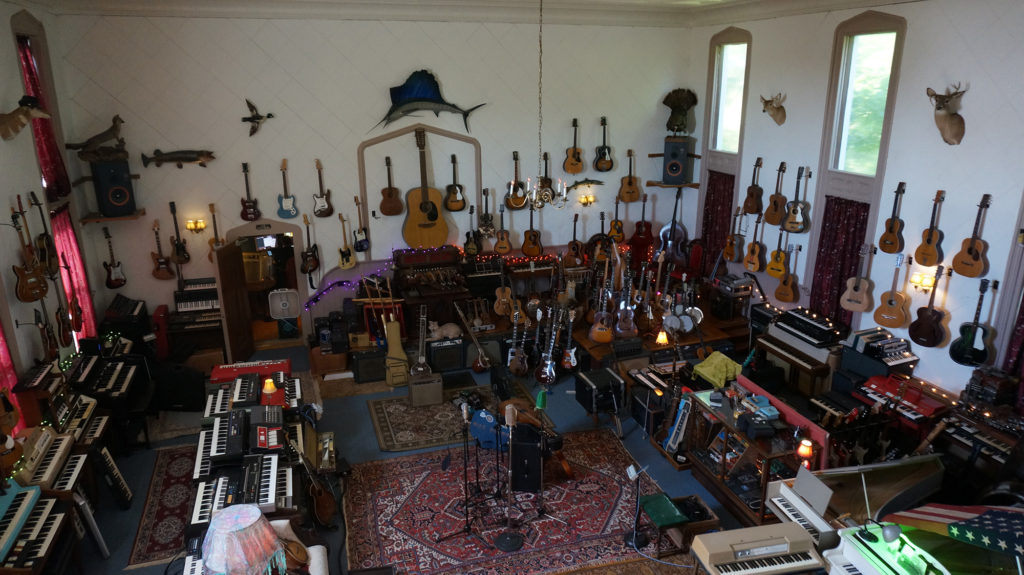 Brown has no shortage of instruments to play. He picks them up wherever he can find them, and never hesitates to make inquiries about a potential new acquisition. The most fitting and accurate definition for what he does as a picker – beyond the musical use of the word – is “to select carefully or fastidiously.” Be forewarned, picking something carefully – in this case classic instruments and musical equipment with distinct sound characteristics, most from the early part of the twentieth century, does not, necessarily, result in a small collection. We could, perhaps rightfully, call his love of collecting, restoring and making music with these instruments an obsession. Albeit a worthy obsession, as his love of instruments has resulted in hundreds of special instruments – and various other artifacts – being salvaged and brought back to life. Although Brown retrofits many acoustic instruments with pick-ups for electric, some remain original – too precious and intact to alter; even for the musical cause. In most cases, refurbishing these instruments means returning them to proper functionality. He does not refinish them. “All these had life before me and you don’t want to take that history away.”
Brown has no shortage of instruments to play. He picks them up wherever he can find them, and never hesitates to make inquiries about a potential new acquisition. The most fitting and accurate definition for what he does as a picker – beyond the musical use of the word – is “to select carefully or fastidiously.” Be forewarned, picking something carefully – in this case classic instruments and musical equipment with distinct sound characteristics, most from the early part of the twentieth century, does not, necessarily, result in a small collection. We could, perhaps rightfully, call his love of collecting, restoring and making music with these instruments an obsession. Albeit a worthy obsession, as his love of instruments has resulted in hundreds of special instruments – and various other artifacts – being salvaged and brought back to life. Although Brown retrofits many acoustic instruments with pick-ups for electric, some remain original – too precious and intact to alter; even for the musical cause. In most cases, refurbishing these instruments means returning them to proper functionality. He does not refinish them. “All these had life before me and you don’t want to take that history away.”
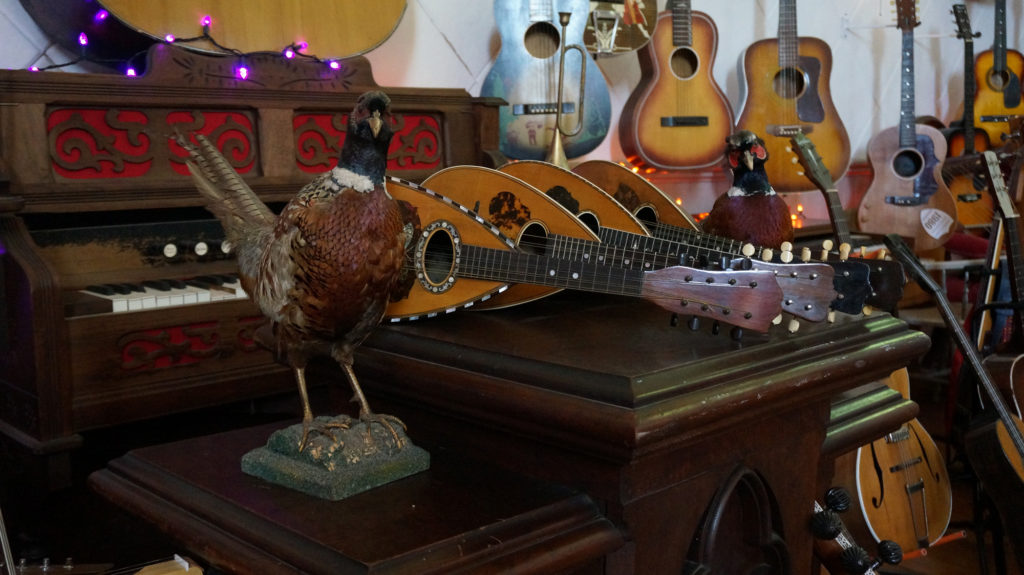 Mike Brown’s home and recording space – which he shares with his life partner and booking manager, Katy Lancaster – is a Methodist church, built in 1828. It is the oldest surviving church building in Livingston County: Built at a time when Andrew Jackson beat incumbent John Quincy Adams; when the Democratic Party (albeit very different from today) was established; and the Erie Canal was enjoying its third year of commerce and transportation. You can feel the spirits of the past come rushing at you when you walk in. On the right is a bar with a very old National Cash register, and spirits – although those were not the types of spirits I was talking about. I am talking about the spirits of the past all around you, loving hands on your shoulder as everywhere your eyes are drawn to objects used, handled and cherished by those who came before.
Mike Brown’s home and recording space – which he shares with his life partner and booking manager, Katy Lancaster – is a Methodist church, built in 1828. It is the oldest surviving church building in Livingston County: Built at a time when Andrew Jackson beat incumbent John Quincy Adams; when the Democratic Party (albeit very different from today) was established; and the Erie Canal was enjoying its third year of commerce and transportation. You can feel the spirits of the past come rushing at you when you walk in. On the right is a bar with a very old National Cash register, and spirits – although those were not the types of spirits I was talking about. I am talking about the spirits of the past all around you, loving hands on your shoulder as everywhere your eyes are drawn to objects used, handled and cherished by those who came before.
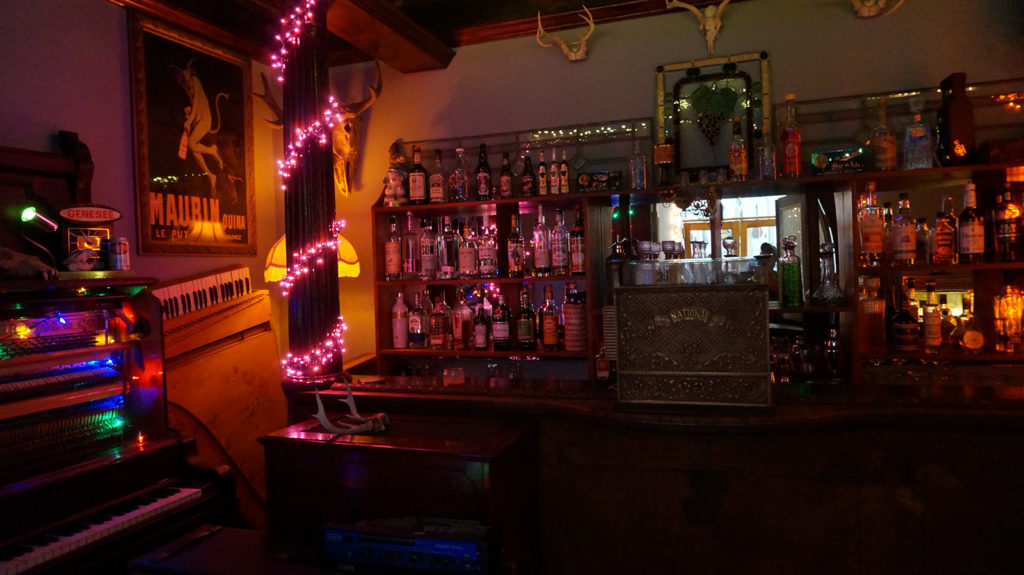 To my left I notice a jukebox, with a fish in it. Not a taxidermist or a hunter, Brown still sees value in preserving taxidermy, keeping the memory of these creatures alive. Looking through the glass double doors into the nave of the former church, you can see a variety of wall mounted and posed animals – including an armadillo holding a beer bottle – there are instruments, everywhere, interspersed with some really cool old lamps. The instruments are organized into categories and sub categories, with string instruments dominating the space. Brown touches on some of their history – and highlights a few of his favorites:
To my left I notice a jukebox, with a fish in it. Not a taxidermist or a hunter, Brown still sees value in preserving taxidermy, keeping the memory of these creatures alive. Looking through the glass double doors into the nave of the former church, you can see a variety of wall mounted and posed animals – including an armadillo holding a beer bottle – there are instruments, everywhere, interspersed with some really cool old lamps. The instruments are organized into categories and sub categories, with string instruments dominating the space. Brown touches on some of their history – and highlights a few of his favorites:
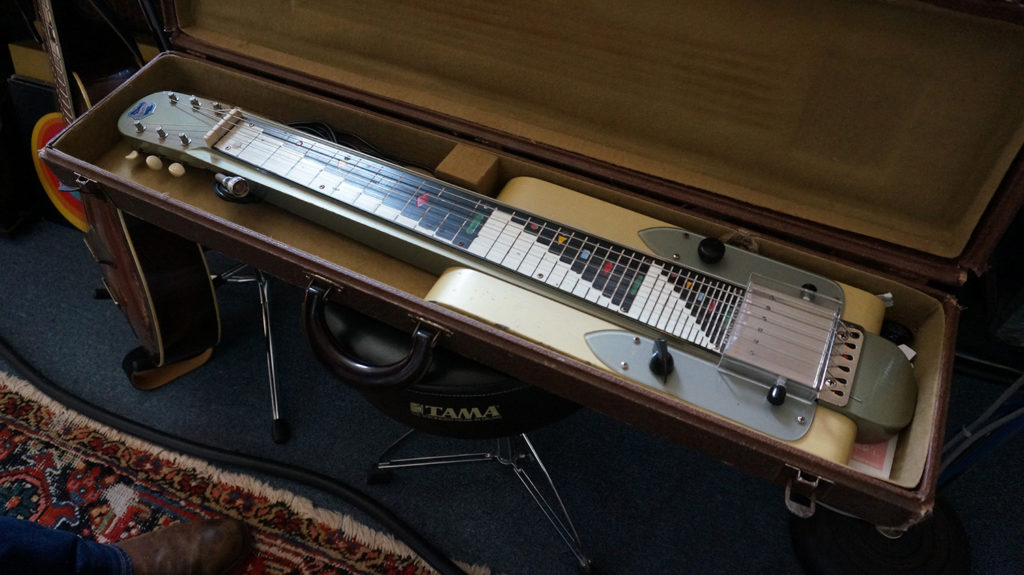
There is the steel guitar he picked up in Warsaw. The proprietor of a summer sale had directed him to a barn when he inquired about musical instruments. There, in its original case, was a 1947 beauty, with all the original components, including the electric cable, intact and in working condition. He loves that the neck has color-coding, which makes it easier to tune into the octaves.
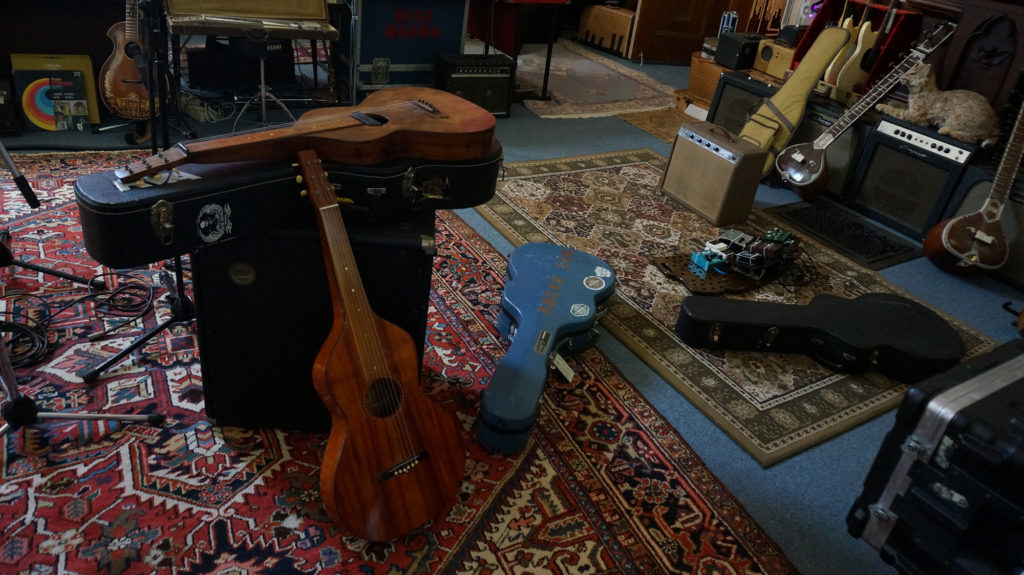 One of Brown’s favorite instruments – and one he goes looking for – is Hermann Weissenborn-made guitars, designed to be played on the lap. He has two of these; only around 3000 were made. The guitars are made out of Koa wood and feature hollow necks. Each model is different; Weissenborn was constantly re-envisioning his instrument. As with any handmade piece of art, wood and construction result in variations, even within similarly designed pieces. In the case of the two Weissenborns – a 1926 made from submerged wood from the northern side of Hawaii Island and the other (1924) made with wood from the drier southern side – the look of the bodies and the tonal qualities are distinct.
One of Brown’s favorite instruments – and one he goes looking for – is Hermann Weissenborn-made guitars, designed to be played on the lap. He has two of these; only around 3000 were made. The guitars are made out of Koa wood and feature hollow necks. Each model is different; Weissenborn was constantly re-envisioning his instrument. As with any handmade piece of art, wood and construction result in variations, even within similarly designed pieces. In the case of the two Weissenborns – a 1926 made from submerged wood from the northern side of Hawaii Island and the other (1924) made with wood from the drier southern side – the look of the bodies and the tonal qualities are distinct.
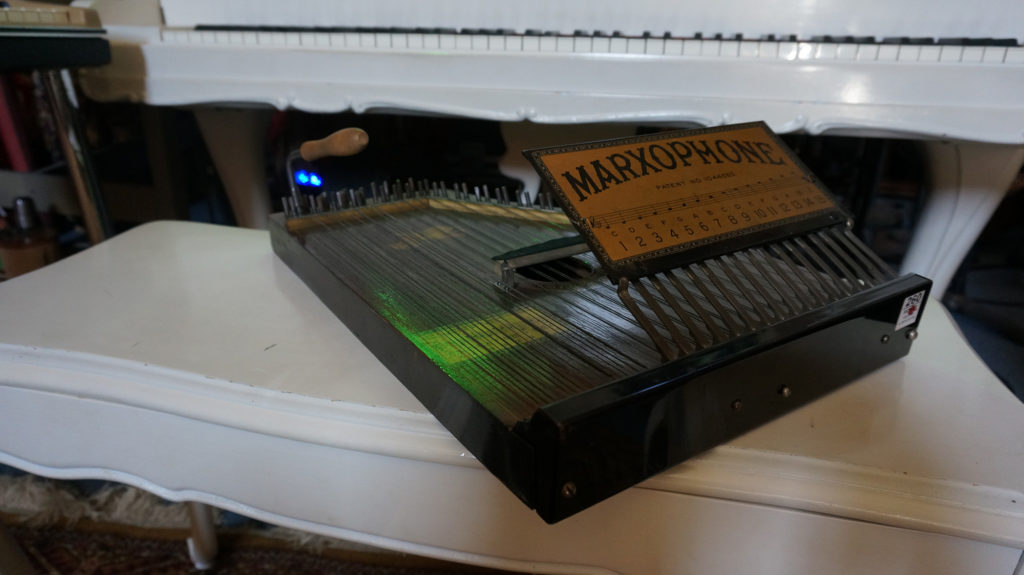 Some instruments in Brown’s extensive – too many to mention – collection, like the Marxophone, are unique to an era and represent the ingenuity of that time. The Marxophone, is a fretless zither played via a system of metal hammers. It features two octaves of double melody strings in the key of C major (middle C to C”), and four sets of chord strings (C major, G major, F major, and D7). He played some for us. It sounded somewhat like a mandolin, a sound I like. Marxophones were made from 1875–1947; the models at Temperamental Recordings were likely from the 1920s or 30s.
Some instruments in Brown’s extensive – too many to mention – collection, like the Marxophone, are unique to an era and represent the ingenuity of that time. The Marxophone, is a fretless zither played via a system of metal hammers. It features two octaves of double melody strings in the key of C major (middle C to C”), and four sets of chord strings (C major, G major, F major, and D7). He played some for us. It sounded somewhat like a mandolin, a sound I like. Marxophones were made from 1875–1947; the models at Temperamental Recordings were likely from the 1920s or 30s.
He also showed us a Mando-Cello, larger than a mandolin with a tuning in 5ths, like a mandolin, but starting in bass C. Despite the beauty in the construction, including the original tuning keys, it is not one of Brown’s favorite instruments to play. Still, as he puts it, “all bring different things to the table.”
All the instruments are here, at Temperamental Recordings, to be played. Some may sit silently by for years, waiting for that special musician to pick them up and add them to their recording for the unique sound it offers. These unique sounds come together in the control room and mastering studio, located to the rear of the building. The space is welcoming, with a relaxing seating area and back lighting provided by salvaged stained glass windows that catch the afternoon sun.
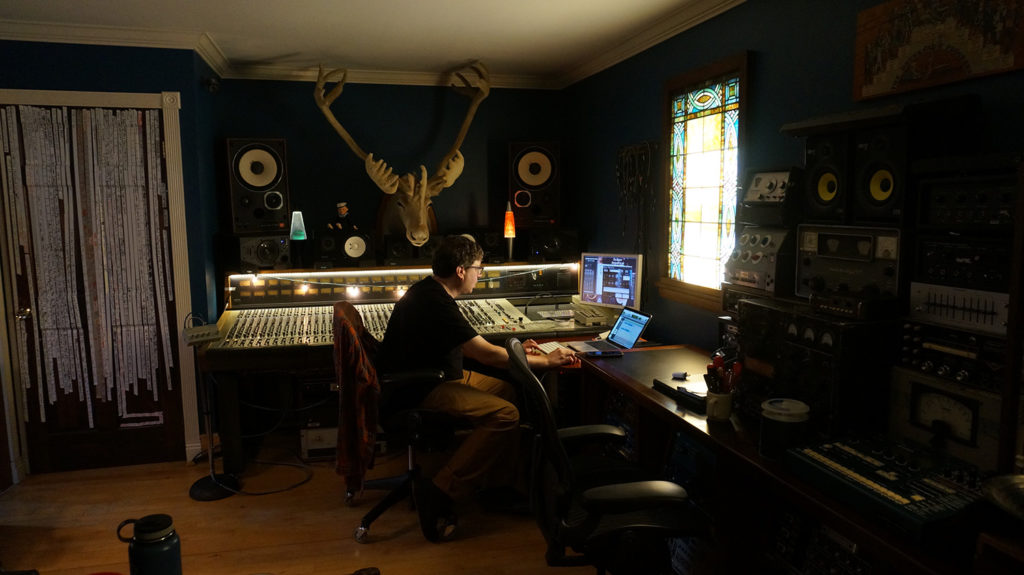
Adjacent to the control room is a smaller space, where the amps and mics are stored. Even here, there is a touch of nostalgia – including older amps and a cabinet filled with classic mics. In 2011 Brown and the studio space were featured on American Pickers on the History Channel due to his expansive mic collection and knowledge of older mics.
Brown pointed out a large wooden box that took up the space along an entire wall. Built first in 1957, this box was a German made EMT (Elektromesstecknik) 140 Reverberation Unit—the first plate reverb, in its day the most popular of artificial reverb solutions for the recording industry. Reverberation, or reverb, is created when sound waves reflect off surfaces in a room. We hear reverb all the time and have learned how to tune it out. Musicians who like reverb as a part of their music have found ways to help us tune back in. Early reverb musicians used rooms and echo chambers to create the effects they wanted. The plate reverb is a specially designed box – enclosing a thin plate of sheet metal suspended from a frame by springs. Pick ups are mounted to the plate and a damping plate to adjust reverb time. At 600 pounds, the unit is not easy to use, but it allows musicians to obtain a classic reverb sound in any space.
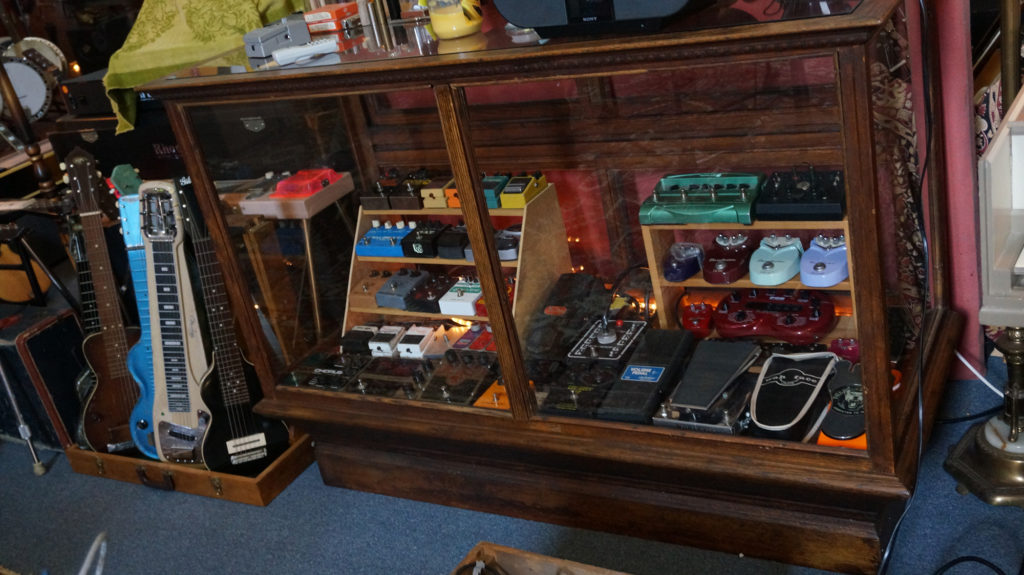 Moving back into the control room, we talked for a brief time with Al, who we had met two days earlier at Noble Shepherd. He was settled in, working on mastering a recent recording by Laura Forster – her melodic voice escaping into the air around us. There was equipment everywhere – most of which I knew nothing about. I did learn from our conversations that mastering is one area where the studio melds the old with the new. An audio interface and digital audio workstation connects the equipment to a computer. This technology allows mastering engineers to stack tracks and edit digitally. These advantages, both Mike and Al agreed, make it too hard to “go back.”
Moving back into the control room, we talked for a brief time with Al, who we had met two days earlier at Noble Shepherd. He was settled in, working on mastering a recent recording by Laura Forster – her melodic voice escaping into the air around us. There was equipment everywhere – most of which I knew nothing about. I did learn from our conversations that mastering is one area where the studio melds the old with the new. An audio interface and digital audio workstation connects the equipment to a computer. This technology allows mastering engineers to stack tracks and edit digitally. These advantages, both Mike and Al agreed, make it too hard to “go back.”
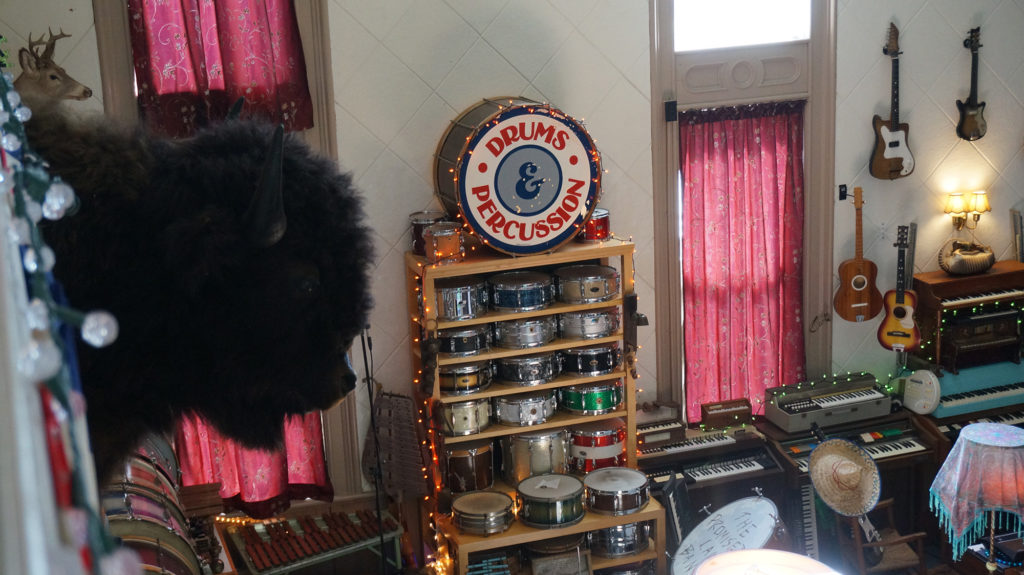 Our final stop was to the former control room space – up a winding set of stairs off the barroom entryway. Standing above the open recording area below, it was easy to imagine musicians doing their thing. The upstairs loft space and another area on the first floor are set up for musical guests, making use of the space by out of the area musicians more practical. Inquiring about the acoustics of the space, Brown shared that this was one of the things that had sold him on the purchase in 2009. He had walked in and clapped and knew that it was perfect. Pointing to the walls, covered in a diamond pattern wallboard, he explained that the original plaster walls were great for live sound, but not suited to recording. That all changed serendipitously in the early 1960’s, when a full basement was dug – by hand – beneath the building. The movement of the church shifted and damaged the plaster walls – replacement was needed. This came in the form of some salvaged acoustic tile – removed in the 1950s from a building in Rochester. As it turns out, that chance use of discarded materials resulted in an excellent acoustic alteration. The tiles are similar in thickness to tiling in recording studios in Los Angeles – where Brown lived and worked in the music industry.
Our final stop was to the former control room space – up a winding set of stairs off the barroom entryway. Standing above the open recording area below, it was easy to imagine musicians doing their thing. The upstairs loft space and another area on the first floor are set up for musical guests, making use of the space by out of the area musicians more practical. Inquiring about the acoustics of the space, Brown shared that this was one of the things that had sold him on the purchase in 2009. He had walked in and clapped and knew that it was perfect. Pointing to the walls, covered in a diamond pattern wallboard, he explained that the original plaster walls were great for live sound, but not suited to recording. That all changed serendipitously in the early 1960’s, when a full basement was dug – by hand – beneath the building. The movement of the church shifted and damaged the plaster walls – replacement was needed. This came in the form of some salvaged acoustic tile – removed in the 1950s from a building in Rochester. As it turns out, that chance use of discarded materials resulted in an excellent acoustic alteration. The tiles are similar in thickness to tiling in recording studios in Los Angeles – where Brown lived and worked in the music industry.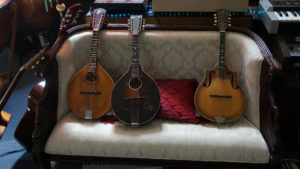
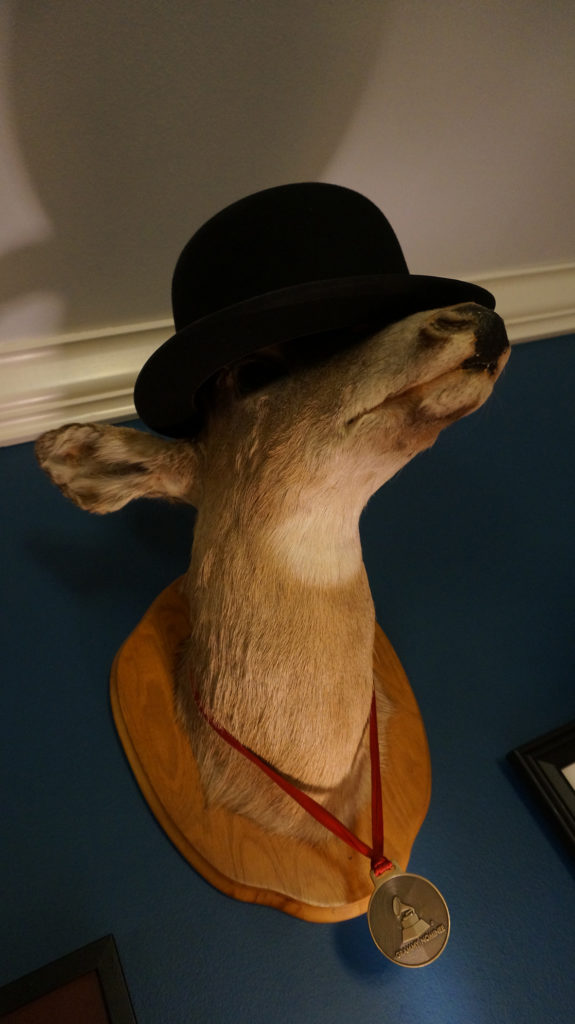 Mike Brown is a Geneseo native, and the loft space also contained reminders of his familial roots, including a wooden boat model owned by a grandfather and images of a great-great grandfather who fought in the Civil War. His local ties are also evident in his first recording – a collaborative album with childhood friend Zac Decamp. Together they released Automatic Music Can Be Fun as the duo “Geneseo.” The album is about personal experiences in Upstate New York. The unique fold out package (like one big scratch-off ticket with a hidden lyrics and a visible poem) was designed by Annie Stoll with artist Brian Grunert of Buffalo (best known for his Ani DiFranco album covers) and the musicians. It received a Grammy nomination for Best Recording Package 2014.
Mike Brown is a Geneseo native, and the loft space also contained reminders of his familial roots, including a wooden boat model owned by a grandfather and images of a great-great grandfather who fought in the Civil War. His local ties are also evident in his first recording – a collaborative album with childhood friend Zac Decamp. Together they released Automatic Music Can Be Fun as the duo “Geneseo.” The album is about personal experiences in Upstate New York. The unique fold out package (like one big scratch-off ticket with a hidden lyrics and a visible poem) was designed by Annie Stoll with artist Brian Grunert of Buffalo (best known for his Ani DiFranco album covers) and the musicians. It received a Grammy nomination for Best Recording Package 2014.
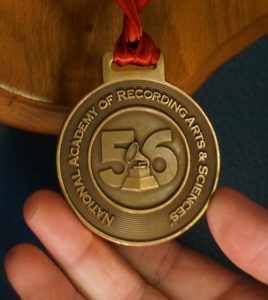 In contrast to Automatic Music Can Be Fun, Brown’s solo recording, American Hotel, took him on the road and away from home. The album was recorded in 50 states with 75 guest musicians. Guests on the album – which is available online only – include a who’s who list of well know musicians that Brown brainstormed and then – over the course of eight years – set out to record with. This extended road trip was also where Brown acquired many of the instruments in his expansive collection.
In contrast to Automatic Music Can Be Fun, Brown’s solo recording, American Hotel, took him on the road and away from home. The album was recorded in 50 states with 75 guest musicians. Guests on the album – which is available online only – include a who’s who list of well know musicians that Brown brainstormed and then – over the course of eight years – set out to record with. This extended road trip was also where Brown acquired many of the instruments in his expansive collection.
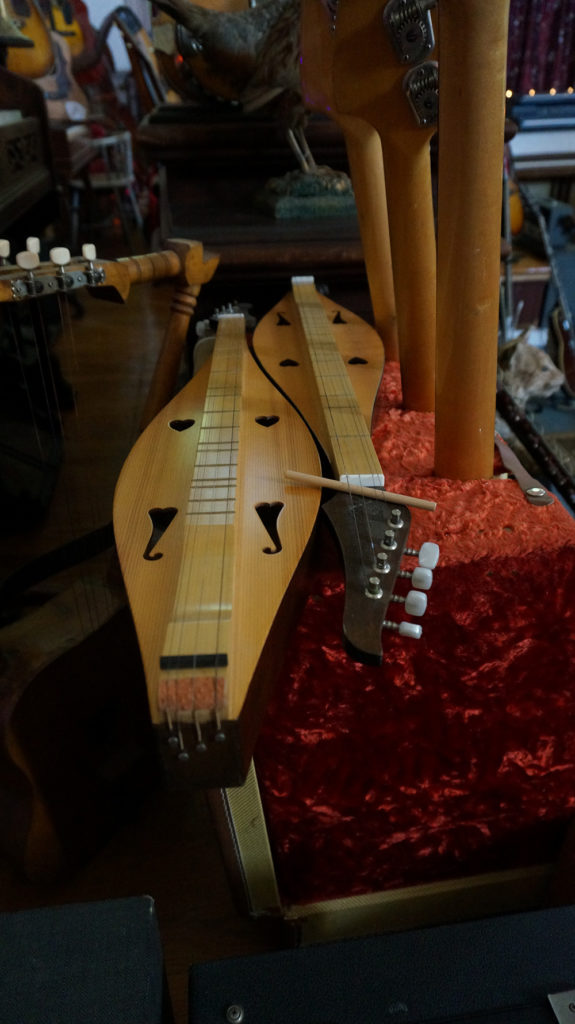
These days, Brown spends much of his time in Groveland, at Temperamental Recordings, not far from where he grew up. For the musicians who come here – including Brown – it offers a space to create music, embracing the sounds of the past while envisioning and creating new sounds.
In stepping into the studio space, I found that I was so caught up in all that is there, with the things that are so much more than mere objects that I strayed from the music that is Mike Brown. Brown focuses on Americana with all original tunes. Katy Lancaster shared with me one exception – “Mary Jane’s Last Dance” – a Tom Petty cover; Brown and Petty share a birth day – albeit 30 years apart. When we saw him perform on the 14th, he was alternating between a Fender 1962 Jaguar, his Gibson and one of his Weissenborns. His looping riffs often made it seem like there were more people up on stage. Thankfully, this is far from my final chance to see and hear Mike Brown perform. He has many upcoming gigs all across the region –- thanks to Lancaster’s skill in setting him up in great regional music venues. Regardless of where his sound evolves, it will incorporate many of the fine instruments and classic sound equipment he has acquired, while reflecting on and respecting the luthiers and musicians that came before.